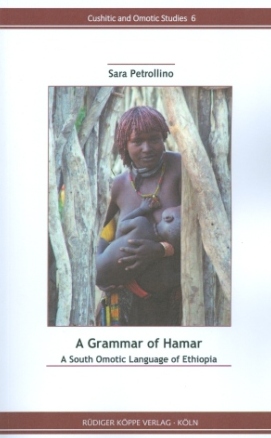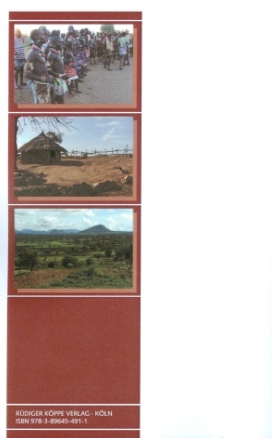



This study focuses on the description of the phonology, morphology and syntax of Hamar, a language spoken by the agro-pastoralist people who are known by the same name, and live in the lower Omo valley of South West Ethiopia.
The study is based on 9 months of fieldwork carried out between 2013 and 2014 in Hamar territories. Language data was gathered from 14 native speakers in Hamar villages, and it amounts to 50 texts of varying lengths and genres. While the exact classification of Hamar remains controversial, this work points out, without any claim of completeness, various putative links to language families and groups.
The Hamar language is spoken by approximately 46,500 people (Lewis 2009). The Hamar refer to their own language as hámar aapó, and they form a cultural and linguistic unit together with the Banna and the Bashada. Their languages are intelligible, but show minor variations in the lexicon and in the phonology. The commonly accepted classification sees Hamar as a South Omotic language within the Omotic family of the Afro-Asiatic phylum.
Whereas there is general consensus on the genetic relationship between Hamar (including its dialects Banna and Bashada), Aari, Dime and Kara (that is, the South Omotic branch of the Omotic family), the controversy concerns the external relationships that this group of languages holds with Cushitic and/or Omotic, and at a higher level, with the Afro-Asiatic or the Nilo-Saharan phylum. The author concludes that ambiguous traits such as the Nilotic elements in the pronominal system or the Afro-Asiatic features in the verbal derivation are the vestiges of millennia of intense language contact that took place between Afro-Asiatic and Nilo-Saharan.
Following the links below you will find further linguistic and ethnographic descriptions of Omotic languages and cultures, as well as the complete text of the reviews by Michael Ahland, Roland Kießling and Ronny Meyer:
The general evaluation of this grammar is absolutely positive. The description is rich, complete and convincing. The grammar is very well written and designed in a way to respect the structural characteristics of the language. A big plus is that all the material described comes from direct collection by the author in several weeks of fieldwork in the Hamar area. To conclude, A Grammar of Hamar definitely gains an important place among the best description ever realised on an Omotic language and in the more general context of the Horn of Africa.
Graziano Savà in Ethnorêma, 13/2017, 157-158
Certainly this work provides excellent data for Omotic and Afroasiatic comparativists and is successful in its primary goal: to provide a clear description of this very interesting and previously underdescribed language. The author is to be congratulated on having added to our knowledge of the least documented Afroasiatic family.
Michael Ahland in Journal of African Languages and Linguistics, 39/1, 2018, 107-110
[...] These critical observations are not meant to diminish the overall value of this highly recommended work, which was completed in the time frame of a PhD project and under challenging field conditions. Petrollino’s Hamar grammar takes us a great step forward in the description of the still little known Omotic languages. It lays the foundation for future comparative studies on the genetic relations between SO and NO and, together with the natural text corpus on which the description is based, it constitutes a substantial source and a valuable starting point for future in-depth studies of specific grammatical issues.
Yvonne Treis in Linguistique et Langues Africaines, 4/2018, 140-150
Hamär is spoken by less than 50,000 people in southern Ethiopia, in an area which was difficult to access until recently. The Hamär, who form a cultural and linguistic unit with the Banna and the Bašaḍḍa, have been extensively researched by the ethnologists Ivo Strecker and Jean Lydall since the 1970s. Later, a number of their students from Johannes Gutenberg-Universität, Mainz, were involved in the research, for which they had to learn the basics of the Hamär language, mostly from Jean Lydall who published the first (and, for a long time, the only) grammatical sketch of Hamär, as well as two articles on specific grammatical aspects. […]
The book under review is the first comprehensive grammar of Hamär. It provides a detailed description of the phonology and morphology, and elaborates on syntax and the interface between morphosyntax and pragmatics. […]
The book is divided into thirteen chapters, followed by three glossed and translated ‘Selected Hamar texts’ (Appendix A, pp. 287–295), a ‘Hamar–English selected lexicon’, and a ‘English–Hamar selected lexicon’ (Appendices B and C, pp. 297–332), and a rather brief ‘Subject index’ (pp. 341–342). The ‘List of morphemes’ (pp. xiii–xiv) is of great help in keeping track of the language examples; the three maps on pages xvii–xix give a good overview of the geographical location of the Hamär and surrounding peoples. […]
This book represents the most detailed treatise of the Hamär language so far, containing a wealth of new data and interesting typological findings. […]
[…] the present grammar is a welcome and important contribution to the documentation and linguistic description of Hamär, a hitherto little-known South Omotic language. The grammar is certainly of interest to typologists and to linguists focusing on the comparative study of Ethiopian and Afroasiatic languages.
Ronny Meyer in Aethiopica, 22/2019, 306-311
© 2025 by Rüdiger Köppe Verlag – www.koeppe.de